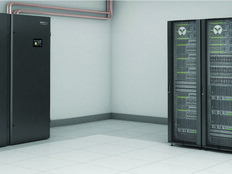The Positive Side Effects of Data Center Consolidation
Like most officials dealing with the Federal Data Center Consolidation Initiative (FDCCI), Kirit Amin, deputy CIO and chief technology officer for the Commerce Department, can rattle off key statistics that help illustrate his agency’s progress in meeting this mandate.
Commerce has already achieved a 90 percent consolidation rate at its headquarters site, dropping its total number of data centers from 14 to five, and Amin expects the building to operate with just one data center in another year or so. Meanwhile, the National Oceanic and Atmospheric Administration (NOAA), the largest of Commerce’s 12 bureaus, is currently on track to shut down 19 of the 400-plus data centers it operates throughout the United States by 2014.
Figures like these, however, tell just a small part of the story, Amin says.
FDCCI — which mandates that the federal government close 40 percent of its data centers by fiscal year 2015 to save the government $5 billion — is also having huge and positive secondary effects on his agency’s security, business continuity and disaster readiness capabilities, Amin says.
“There are definitely some very exciting side benefits of doing this consolidation,” Amin says. “It helps from a physical security standpoint because your locations are fewer and there are fewer network connections, which makes it easier to monitor and control your security entry and exit points.”
FDCCI is also helping to provide the transparency needed to ensure more effective disaster preparedness and continuity of operations. “Before, we might not have known about that server under the desk, so how are we supposed to provide failover and continuity?” Amin asks. “But now consolidation is helping us identify and document everything, so we know what the inventory is, we know where the systems are, and where our criticality is.”
When Less Technology Equals More
Steve O’Keeffe, founder of MeriTalk’s Data Center Exchange and Cloud Computing Exchange, says that while security, continuity of operations and disaster preparedness are not the primary benefits of FDCCI, they are inevitable if the effort is undertaken properly. “Anytime you can make things simpler, you make them more secure and more manageable,” he explains.
The General Services Administration (GSA), which is executing an aggressive plan to consolidate many of its data centers by 2014, is seeing this concept in action.
Patrick Mulcare, an enterprise architect for GSA, says FDCCI has provided a structured means to assess how well the agency’s current infrastructure meets enterprise requirements for, among other things, IT security, disaster readiness and continuity of operations.
The revised number of federal data centers in operation, more than double the previous estimates
SOURCE: Congressional testimony of David Powner, director of IT management at the Government Accountability Office
“Data center consolidation affords us the opportunity to migrate the data to a more secure facility, in addition to one that’s more efficient to operate,” Mulcare says.
Darren Smith, a program manager for the Office of the CIO at NOAA, agrees, noting that consolidation forces agencies to take a fresh, detailed look at their IT systems and how they interact “where the boundaries touch one another.”
Right Place, Right Technologies
Consolidation — combined with breakthroughs in networking, broadband capacity, virtualization and cloud technologies — also gives agencies the ability to bring their best IT resources to bear in any given situation.
When the National Weather Service recently opened a new research and operations site in Alabama, for instance, NOAA IT officials chose to house the corresponding computing power not locally but rather split between data centers in Boulder, Colo., and Fairmont, W.Va.
“By separating the concerns and limitations of employees and offices from where the computers live, we can identify sites where we can have higher reliability and availability and better security,” Smith explains. “And we can get a lower cost of ownership, because you can put the data where it’s going to operate more efficiently.”
The Fairmont site, NOAA’s High Performance Computing Data Center, is the agency’s newest, largest and most modern IT data facility. It has “modern security controls, lots of cameras, everything is electronically recorded and monitored, and we have a new firewall system,” Smith says.
Because it had room for growth and is in an ideal location out of the path of most extreme weather systems, it was tapped as a core data center.
The center is being prepared as a backup site for the National Weather Service Telecommunications Gateway in Silver Spring, Md., and the Joint Polar Satellite System, which is primarily housed in the NOAA Satellite Operations Facility in Suitland, Md.
Commerce’s Amin notes that the FDCCI effort results in the transparency and accountability that agencies need to develop enterprise security capabilities.
For example, his office is implementing an enterprise security operations center, which, aligned with the network operating center, will “give us a one-eye view of our whole infrastructure,” Amin explains.








